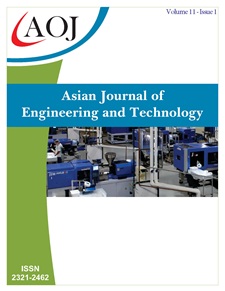Use of Mixtures of Shredded Face Masks and Fine Soils in Layers of Flexible Pavements
DOI:
https://doi.org/10.24203/nka73h16Keywords:
road engineering; road soils; subgrade; subbases; waste; single-use face mask; light blue face mask; environmental threat; COVID-19Abstract
In recent years, since the onset of the COVID-19 pandemic, there has been a disproportionate increase in the use of face masks by the general population, which generates that a residue that was previously almost exclusively pathogenic, starts to present a predominant component in terms of the residential area. The latter leads to the generation of an environmental threat if solutions are not adopted regarding their recycling. One of these solutions may be to dispose of this residue in pavement structures, given the potential structural contribution that the textile that constitutes them may present.
Given this, the LEMaC Centro de Investigaciones Viales UTN FRLP-CIC PBA (Argentina) analyzes the existing antecedents, concluding that the field of application in fine soils has not yet been explored. To cover this, a pre-feasibility study for the use of these shredded wastes mixed with fine soils in subbase layers and improved subgrade is being developed.
The study allows obtaining good preliminary results from the mechanical point of view, mainly with the California Bearing Ratio test, which are complemented with an analysis regarding the environmental implications, the available shredding forms, and the materialization on site. All these aspects are covered in this article.
As conclusions, it can be pointed out that the optimal content can be between 1.5% and 2.0% of face masks in weight above 100% of dry soil weight, which would translate into more than 1,000,000 face masks per lane for every 100 m of a treated layer.
References
Consejo Nacional de Investigaciones Científicas y Técnicas de Argentina, “Los barbijos son indispensables pero muy contaminantes”, 2021. [En línea]. Disponible en: https://ier.conicet.gov.ar/los-barbijos-son-indispensables-pero-muy-contaminantes/. [Accedido: 28-12-2021]
S. Nuñez Montoya & S. Uema, “Uso de barbijos (mascarillas) en la pandemia por COVID-19”, Repositorio Digital, Universidad Nacional de Córdoba, Argentina, 2020.
J. Elcacho, LaVanguardia.Com de España, “Descubren miles de mascarillas convertidas en residuos en islas deshabitadas”, 2020. [En línea]. Disponible en: https://www.lavanguardia.com/natural/20200313/474107668765/impacto-ambiental-coronavirus-covid-mascarillas-residuos-contaminacion-playas-china.html. [Accedido: 28-12-2021]
Marketers, “Top 25 de productos que más crecieron en ventas online en la Argentina”, 2020. [En línea]. Disponible en: https: http://www.marketersbyadlatina.com/articulo/6726-top-25-productos-que-mas-crecieron-en-ventas-online-en-la-argentina. [Accedido: 28-12-2021]
K. Oanh Ha, “The Quest for a Disposable Mask That Won’t Pollute”, Bloomberg Green, 2021.
C. Olmedo & I. Ceberio de León, “Basura y COVID-19 ¿el nexo que no estamos queriendo ver?”, Proyección 28, vol. XIV, pp. 142-167.
P. Squarcia, “Cuidarse del COVID-19 sin descuidar el medioambiente”, Consejo Nacional de Investigaciones Científicas y Técnicas, Argentina, 2021.
A. S. Rodríguez, “Los objetivos del Desarrollo Sostenible y la Carretera”, Carreteras: Revista técnica de la Asociación Española de la Carretera, n. 232, pp. 8-16.
M. Saberian, J. Li, S. Kilmartin-Lynch & M. Boroujeni, “Repurposing of COVID-19 single-use face masks for pavements base/subbase”, Science of the Total Environment, vol. 769, p. 145527.
G. Gioberchio, “Cómo desechar los residuos de los pacientes con COVID-19 que cursan la enfermedad en sus casas”, Infobae, 2020.
J. J. Rivera, H. D. Bianchetto & A. F. Queizán, “Modelo para corrección de dosaje de riegos de liga sobre superficies fresadas en refuerzos asfálticos”, Carreteras: Revista técnica de la Asociación Española de la Carretera, n. 218, pp. 46-54.
J. J. Rivera, “De poner asfalto a construir un pavimento flexible multicapa”, Acercando la Vialidad a los Arquitectos, Portal Dolmen, 2021.
Normas de Ensayo. Dirección Nacional de Vialidad, Argentina, 2001.
Pliego de Especificaciones Técnicas Generales. Dirección Nacional de Vialidad, Argentina, 1998.
Downloads
Published
Issue
Section
License
Copyright (c) 2025 Ignacio Zapata Ferrero, José Julián Rivera, Nicolás Battista

This work is licensed under a Creative Commons Attribution-NonCommercial 4.0 International License.
- Papers must be submitted on the understanding that they have not been published elsewhere (except in the form of an abstract or as part of a published lecture, review, or thesis) and are not currently under consideration by another journal published by any other publisher.
- It is also the authors responsibility to ensure that the articles emanating from a particular source are submitted with the necessary approval.
- The authors warrant that the paper is original and that he/she is the author of the paper, except for material that is clearly identified as to its original source, with permission notices from the copyright owners where required.
- The authors ensure that all the references carefully and they are accurate in the text as well as in the list of references (and vice versa).
- Authors retain copyright and grant the journal right of first publication with the work simultaneously licensed under a Attribution-NonCommercial 4.0 International that allows others to share the work with an acknowledgement of the work's authorship and initial publication in this journal.
- Authors are able to enter into separate, additional contractual arrangements for the non-exclusive distribution of the journal's published version of the work (e.g., post it to an institutional repository or publish it in a book), with an acknowledgement of its initial publication in this journal.
- Authors are permitted and encouraged to post their work online (e.g., in institutional repositories or on their website) prior to and during the submission process, as it can lead to productive exchanges, as well as earlier and greater citation of published work (See The Effect of Open Access).
- The journal/publisher is not responsible for subsequent uses of the work. It is the author's responsibility to bring an infringement action if so desired by the author.


